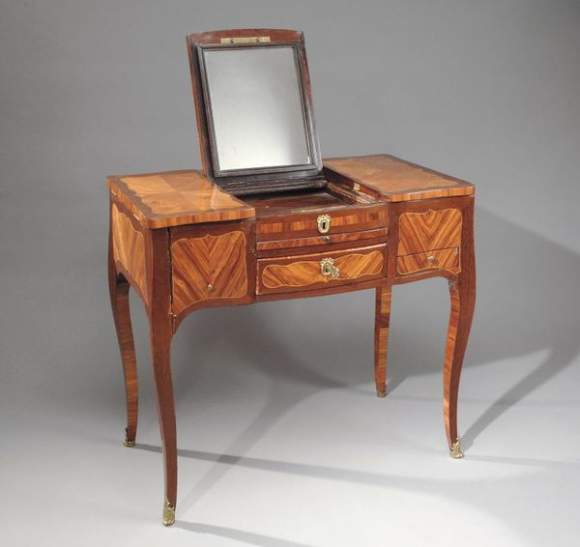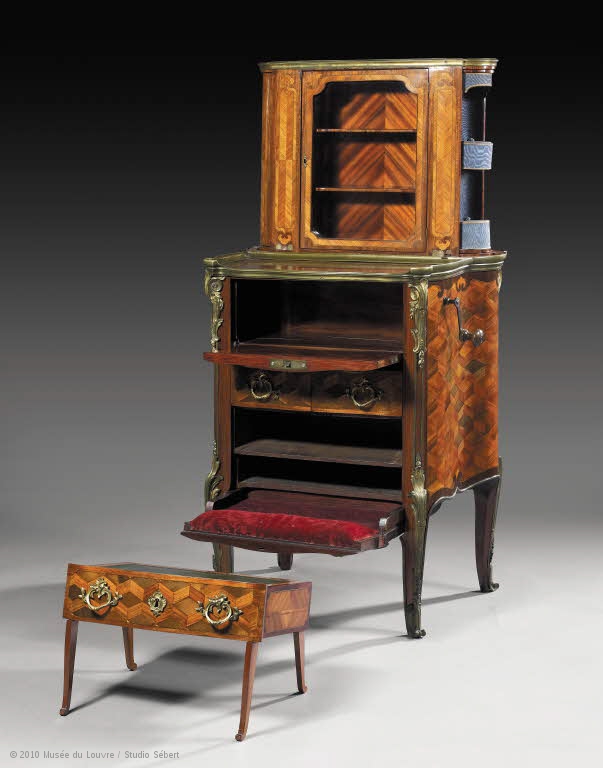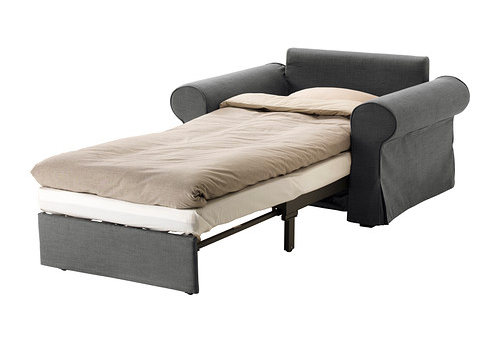Convertible furniture from yesterday and today
Clever and practical, the convertible piece of furniture is not new and continues to evolve, to become a transformable decorative element. With a mechanism, it can have a dual function and save real space, perfect for small spaces. If the table was the first mechanical piece of furniture, others followed such as the dressing table, the desk or the convertible sofas .
Some furniture is the pride of European heritage, with pieces of great complexity and precious materials. Today, convertible furniture is both light and versatile, making it easy to set up a studio. They can also have a technological function, by being connected.
HISTORIC CONVERTIBLE FURNITURE
The mechanical unit was created with the aim of satisfying several requirements: ergonomics, space saving, versatility and also practical function. The 18th century marks the beginning of the history of convertible furniture. In the sense that the mechanisms are ingenious for the time.

Louis XV Dressing Table
-
Common furniture
The table is the piece of furniture which was the subject of the first transformations, from the 16th century. With retractable legs or extensions, it can be stored more easily, moved or expanded.

Louis XVI Secretary Furniture
The desk can serve as a storage space and secretary. With a tilting top, the chest of drawers opposite is the perfect example of an authentic Louis XVI hinged secretary, with a leather desk pad, created by Gaspard Schneider. The monk bench or monks' bench is a piece of furniture with a triple function: it can be a bench, a table whose back becomes the top and a chest. It could accommodate chickens and serve as an indoor “chicken coop”. The dressing table could serve as both a desk or a console. She hid a mirror under her top which could tilt and which opened onto a storage niche to store skincare products.
-
Famous furniture
If we had to choose only one piece of mechanical furniture. This would be Louis XV's roll-top desk at the Château de Versailles.

Office or Cabinet of the King, by Jean-François Oeben
Also called Bureau or Cabinet du Roi, it was designed by Jean-François Oeben, cabinetmaker to the king and faithful to Madame de Pompadour and completed, in 1769, 9 years later, by Jean-Henri Riesener, his student who took over following his death, for an amount of 62,000 pounds. A jewel of French furniture with bronzes and marquetry, this piece of furniture has the particularity of closing completely with a single turn of the key and opens by pressing a button. Described as a safe, the goal for Louis XV was to be able to hide strategic documents and secret information, collected by his spies.

Mechanical Table with Two Ends by Oeben

Burgundy table by Oeben
Oeben, the king's cabinetmaker, also created more complex models of mechanical tables such as the burgundy table. According to the Louvre website, this table can have a function as a library, a prie-dieu, a bedside table and a secretary. It was intended for the eldest grandson of Louis XV, the Duke of Burgundy, who was disabled. You should know that Marie-Antoinette placed all her trust in her favorite cabinetmaker Jean-Henri Riesener, who was Oeben's disciple and specialist in mechanical tables.
Jean-François Oeben created other, much simpler table models. In general, the mechanism is operated by a crank, with two opening systems, by key and by buttons. We are talking about a mechanical table with two purposes. Among the other pieces he created, two pieces of furniture: the Queen's table at the Petit Trianon and a writing table. We notice that these pieces are of great finesse, with a writing desk.


A masterpiece of inestimable value. Roentgen's secret table, in the video above, still amazes with the plurality of its mechanisms. Designed by German cabinetmaker David Roentgen who worked for Louis XVI, this versatile piece of furniture was the property of King Frederick William II of Prussia at the end of the 17th century. This wonderful piece of furniture includes a clockwork system, weight mechanisms, secret drawers that can be opened by pressing buttons and keys...
He also created the magnificent Tronchin-style mechanical table shown opposite. Ingenious, it allows you to raise the tabletop to the desired height and tilt its desk. However, this type of table is not his invention. It comes from Dr Tronchin, who discovered in the 18th century that there was a link between working posture and back pain, hence the creation of his ergonomic table.
-
Convertible sofas

Sofa Bed by Albert Ducrot
The history of the sofa will begin much later at the beginning of the 20th century. Albert Ducrot, a graduate of the School of Arts and Crafts in Châlons-sur-Saône and upholsterer, is credited with the invention of the sofa bed. At the head of the Ducal company, the capital's leader, he launched the first armchairs that could be transformed into a chaise longue, with a pull-out footrest.
Albert Ducrot's first creation in terms of mechanical sofa was the Merveille bench, with complete bedding and a box to store the mattress. Creating this model required patience, as the mechanism for opening and closing the sofa was complicated to operate and synchronize. At the Paris fair, the model attracted the public, which led to the filing of patents.

Merveille bench by Albert Ducrot
La Maison du Convertible is the creator of the convertible sofa as we know it today, particularly in the versions for daily sleeping. Since 1982 the brand has democratized the concept of the sofa bed while drastically raising the level of quality to today result in functional, designer and comfortable furniture.
TODAY’S CONVERTIBLE FURNITURE
Each room in an apartment or house can accommodate convertible furniture, in a practical spirit. At a time when refined decoration is trendy, it is fashionable to choose transformable furniture, which will save space and ventilate the space.
-
The living room / dining room

Convertible Armchair
A living room, the living room accommodates high-tech equipment. The television, the bookcase, the coffee table and of course the sofa. The latter can be convertible, whether it is the sofa bed, sofa bed, BZ, ottoman bed, chaise longue or pull-out sofa bed version. To help you find the model best suited to your needs, here is the Convertible Sofa Guide which gives you all the information on each form of living room. Daybed version, the convertible armchair can have a pull-out footrest, to save space, while thus benefiting from maximum comfort.

Stackable wooden armchair
Resolutely designer, it is possible to turn to stackable wooden armchairs, like Russian dolls. Hollow like matriochkas, the largest armchair accommodates the smallest, for guaranteed space saving. Who would say that a bookcase with many niches could contain a set with 4 chairs and a table? Design and practical, it therefore offers unsuspected space savings. Simply slide the furniture into the locations provided for this purpose, so that it is neither seen nor known when stored.
 Space Saving Library[/caption] [caption id="attachment_197" align="alignright" width="450"]
Space Saving Library[/caption] [caption id="attachment_197" align="alignright" width="450"] 
Extending Table
Everyone knows the extending table system. The first fairly elaborate models date from the Louis Philippe style. Today, the table can be extendable, thanks to a telescopic mechanism and integrated extensions. It is possible to go from a you and me table for 2 people to a large table for 10 people.
Intended for boats, the table in the video below can be enlarged. Not necessarily with extensions, but by opening like a flower, in a simple circular movement. It can transform and double in size, thanks to a wheel. It forms a kaleidoscope in relief when it is opened.
[embed]https://www.youtube.com/watch?v=Bh_qn62zny0#t=18[/embed]

Liftable Coffee Table[
If it is trendy to eat on your coffee table, it is much more practical to be able to choose the height of the furniture. With a gas piston, the lifting coffee table can have the height you want to the nearest centimeter, to adjust according to your needs and in particular your desires.
The dining room table can be playful, by offering a billiard table under its top. Transformable, the game can be English, American or French, with a space provided to store the cues.
 Billiard Table
Billiard Table
-
Bedroom
In a bedroom, the bed takes up the most space. In fact, a mattress for 2 people has a length of 1.90 m, which makes it a space hog.

Wardrobe-Bed
The bed cabinet is the most popular model. In just a few simple steps, it allows you to lower the bed, hidden behind a wardrobe. With a real slatted base, it provides the same comfort as a traditional bed. The duvet and blankets can stay in place, providing the possibility of immediate sleeping. This type of convertible is also available as a sofa bed cabinet, with an integrated sofa. Living room furniture can also be transformed into a bed. Hidden under a television panel, it is also possible to place a folding single bed.
Discover some other ideas for Murphy beds , to place in the 4 corners of the house, in this video . The cupboards also hide optimized storage spaces. With niches under the stairs, rotating shoe racks, a chest, a telescopic mirror or overhead wardrobes with electric or manual control. It is even possible to set up a laundry room, especially with a foldable ironing board. Dedicated locations for laundry bins and compartmentalized drawers for cleaning products.
-
The layout of the studios
In certain cities in France, the m2 is worth gold. When you live in a small home, you want to make the most of the space. Great architects like Philippe Demougeot have specialized in the layout of studios. And they transform spaces between 8 and 15 m2 into real functional apartments. The height of the ceiling can thus be used to create a mezzanine. The spaces also stand out with different ambiances and lights. Storage is optimized as much as possible. It is even possible to have a shower, a wall-hung toilet and a sink, in a 1m2 bathroom.
CONNECTED DEVICES
Today, if the mechanism is important, furniture is becoming convertible from a technological point of view. Indeed, it is possible to transform any thing into a connected object. There are systems through which we can place sensors on all objects. And the person receives the data by email or text message.
So, for example, it is possible to know if your child is brushing their teeth well and how many times a day, by placing a sensor on their toothbrush or if you have watered the plants well, with a sensor on the watering can . We can easily imagine that a sensor equipped with a motion detector, a thermometer and a proximity sensor could be placed on the seat of the sofa, to collect data such as the time spent resting or spent in front of the sofa. television. A good idea for better parental control or statistics fans!

The coffee table becomes an interesting and powerful connected object. Like a giant computer screen, working with an operating system or a maxi-format touchscreen tablet, downloading applications. The sofa can be a connected object like any other. It can accommodate a smartphone or tablet, as a charging station or connect them via a USB cable.
It can therefore interact with multimedia devices and facilitate wireless connection, thanks to a universal remote control. Connected via Bluetooth, it allows you to listen to music. If you want to know everything about the sofa that tweets by itself, for example, go to the 21st century designer sofas page.



 The up and down coffee table: practical on a daily basis for small homes
The up and down coffee table: practical on a daily basis for small homes
 Liftable table: which design to go with my sofa?
Liftable table: which design to go with my sofa?
 Liftable coffee table: round or rectangular? Our advices
Liftable coffee table: round or rectangular? Our advices
 Pantone Color 2026: Cloud Dancer, the warm white to adopt at home
Pantone Color 2026: Cloud Dancer, the warm white to adopt at home
 Tips and good ideas for furnishing a studio for rental
Tips and good ideas for furnishing a studio for rental
 What size sofa should you choose? The ultimate guide to a perfect purchase
What size sofa should you choose? The ultimate guide to a perfect purchase





















































